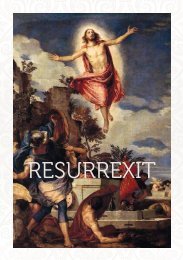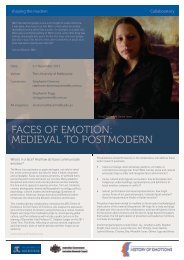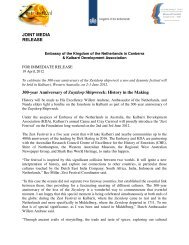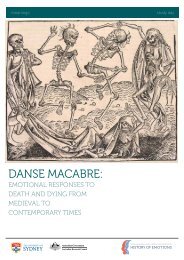Download our K-12 education pack - ARC Centre of Excellence for ...
Download our K-12 education pack - ARC Centre of Excellence for ...
Download our K-12 education pack - ARC Centre of Excellence for ...
You also want an ePaper? Increase the reach of your titles
YUMPU automatically turns print PDFs into web optimized ePapers that Google loves.
Supporting Res<strong>our</strong>ces stories <strong>for</strong> teachers & students 2013<br />
South Africa, Far from Home<br />
stories by winthrop pr<strong>of</strong>essor susan broomhall<br />
Beachcomber) by the Dutch, a name which showed how<br />
disinterested the Europeans were to understand local identities<br />
and cultures. It was easier to give indigenous people Dutch<br />
names that they were familiar with, than learn those they used<br />
themselves. The VOC commander van Riebeeck wrote in his<br />
diary in 1656 how ‘Harry maintained that the land <strong>of</strong> the Cape<br />
belonged to him and the Kaapmans [Capemen, the Dutch name<br />
<strong>for</strong> the Goringhaiquas] but he was told that [as] the Company<br />
also required pasturage … his claim to ownership <strong>of</strong> this Cape<br />
could not be entertained.’<br />
For van Riebeeck, this was the end <strong>of</strong> the matter, but not so <strong>for</strong><br />
the Goringhaiquas. Autshumato began to steal cattle from the<br />
Dutch, by whom he felt he had been cheated. In 1658 van<br />
Riebeeck ordered that he was to be placed as punishment on<br />
Robben Island. Autshumato escaped on a rowboat after 18<br />
months. But life had changed <strong>for</strong>ever <strong>for</strong> the Goringhaiquas.<br />
Autshumato eventually sought permission from the new VOC<br />
commander, Zacharius Wagenaer, to return to his homeland<br />
–now the Cape Colony – and to continue his work as an<br />
interpreter between his people and the Europeans. Resistance to<br />
the VOC rule had failed, perhaps negotiation from within would<br />
be more successful.<br />
The arrival <strong>of</strong> the VOC would prove to be just as damaging <strong>for</strong> the<br />
San people with whom the Europeans came into regular contact<br />
at a slightly later period as they moved to settle lands further<br />
inland and to the east. The San people, <strong>of</strong>ten called Bushman by<br />
the Europeans, did not herd cattle to the same extent as the<br />
Khoikhoi but lived a more egalitarian, hunter-gatherer lifestyle.<br />
They were nomadic, travelling in small groups within their<br />
traditional lands as their needs and cultural beliefs required.<br />
This was not a way <strong>of</strong> life that the Europeans understood and<br />
they did not see signs <strong>of</strong> land ownership such as farming<br />
practices and permanent houses that were familiar to them.<br />
VOC settlement had by this time vastly expanded beyond the<br />
original Cape colony. Settlers wanted larger holdings <strong>for</strong> farming<br />
livestock and moved increasing to the east to find suitable lands.<br />
In doing so, European settlers were coming into new contact with<br />
populations that had not experienced settled colonisation be<strong>for</strong>e.<br />
This period is known as the Frontier Wars, as Europeans,<br />
Khoikhoi, San and Xhosa peoples fought <strong>for</strong> over a hundred years<br />
<strong>for</strong> control <strong>of</strong> these lands.<br />
For the San, the period would be marked by dispossession and<br />
loss. They fought back largely by attacking farmers’ livestock and<br />
dogs, using poisoned arrows, and burning houses and crops.<br />
They hoped that the loss <strong>of</strong> goods would drive the Europeans<br />
away. However, the famers, armed with guns, organised hunting<br />
parties to kill the San ‘raiders’ that they held responsible. This<br />
bitter violence resulted in many deaths, despite the instructions<br />
<strong>of</strong> VOC <strong>of</strong>ficials to maintain order and resolve disputes in other<br />
ways. The population <strong>of</strong> the San was markedly reduced, their<br />
lifestyle destroyed, and their lands removed <strong>for</strong>ever.<br />
Some Europeans and San people were able to negotiate local<br />
peace. Some white farmers in the north-eastern Cape were<br />
reportedly known to shoot game to support San people who had<br />
previously occupied the area. San people also began to ride<br />
horses and some moved into the waged economy as farm<br />
workers. Rarely were these adaptations made by choice though.<br />
Few San people continued to sustain their nomadic lifestyle into<br />
the twentieth century and government modernisation schemes,<br />
particularly in Botswana, from the 1950s to 1990s enc<strong>our</strong>aged<br />
San people to adopt farming <strong>for</strong> their survival. In recent c<strong>our</strong>t<br />
cases, the San people in Botswana have won back their rights to<br />
access water-holes and to hunt in lands from which they had<br />
During the later eighteenth century, the San people realised that<br />
their lifestyle and lands were in jeopardy from Europeans. The<br />
38 FAR FROM HOME: ADVENTURES, TREKS, EXILES & MIGRATION












